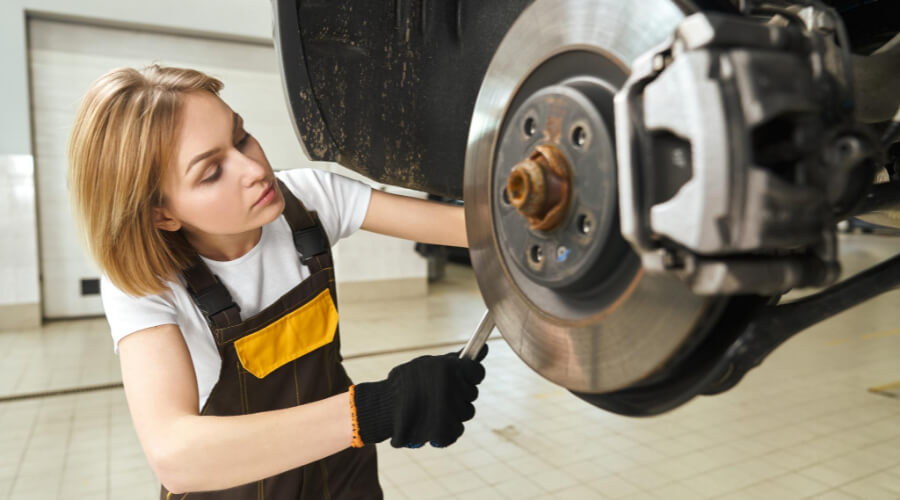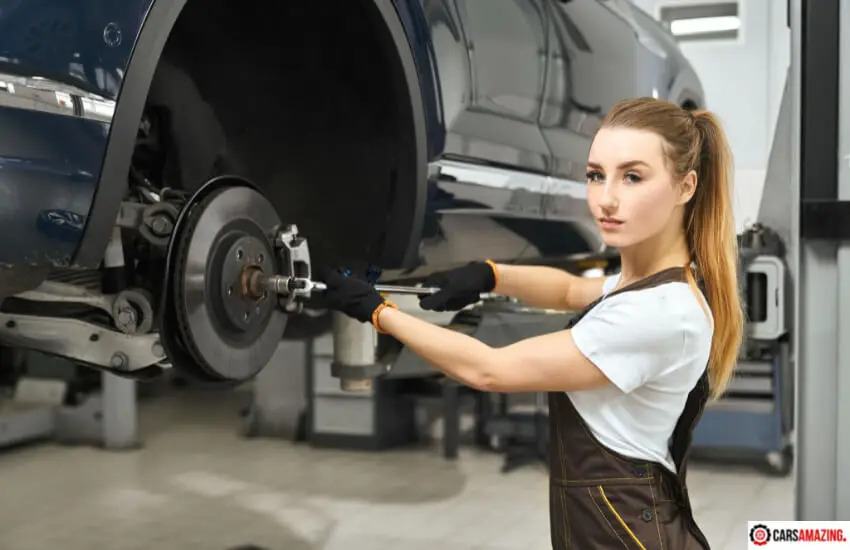Last Updated on February 4, 2023 by Leepu Da Maxim
Brake bleeding is the process of releasing air or fluid vapor trapped within the brake lines of the hydraulic braking system. Entrapped air in the brake lines compromises the efficiency of your car’s braking system. Bleeding is done by opening a small valve at the wheel cylinder to permit the measured amount of brake fluid out of the system.
Key Takeaways
- If you want to bleed the car brakes then you have to ensure that the brake fluid is at the correct level and not contaminated
- You have to open the bleeder valve and let the brake fluid flow until it runs clear
- Brake fluid creates a hydraulic force that activates the brake calipers which slows down or stops the wheels
- Bosch ESI6-32N Brake Fluid has a low viscosity of -40 degrees Celsius and a high wet boiling point of around 365 Degree Fahrenheit
The Function Of Brake Fluid In The Braking System?
The brake fluid primarily transfers energy from the main cylinder to the four corners of your car. For the fluid to perform optimally, it resists compression by maintaining the liquid state. If you desire to keep your brake fluid in top-notch condition, it is necessary to bleed the brakes to get rid of fluid vapor or air.
You might be wondering how air finds its way into the braking system. Here is how: if the system’s seal is compromised, for instance, when replacing flex lines, the fluid causes vapor when it boils. The moisture trapped in the braking system negatively impacts its efficiency of the braking system.
Another way that allows air into the brake lines is by letting the brake pads wear. When the pads become thin due to wearing off, the brake fluid level in the master cylinder decreases since you require more fluid to press the pads into the braking surface. When filling fluid into the system, there are chances of introducing bubbles.
This article discusses the effect of trapped air in the brake lines and a step-by-step guide on manually bleeding your brake.
Effects Of Air In Brake Lines
If air vapor enters the brake lines, the performance of the braking system becomes compromised. The brakes become spongy and ineffective in stopping the car. With air in the brake lines, not even new brake pads can function effectively.
Since it is easier to compress air than liquids, the air entrapped in the brake lines is compressed when applying braking pressure. The response to the force applied is a spongy feel that is inefficient to stop your car effectively. The only plausible remedy to the situation is by bleeding your brakes.
Bleeding Your Brakes Manually- A Step-By-Step Guide

The manual bleeding process is recommended when you wish to perform the task personally with the help of a friend. Here below are the steps followed for successful brake bleeding.
1. Jack Up Your Car
For easy access to the nozzle (bleeder screw), you must jack up your car. The screw is located behind each brake. Lie on a creeper while beneath the car. With the creeper, it becomes easier to slide around.
2. Loosen The Bleeder Screw
Use bleeder wrenches that fit the bleeder screw. The wrench prevents damage to the screw’s head. Suppose the screw is tight; spray it with a penetrant such as WD-40. After loosening, tighten it again lightly.
3. Keep An Open Jar Near The Nozzle
Keep a jar near the bleeder screw. Then fix a hose to the end of the nozzle, and another end should be in a jar. Ensure you fill the jar with brake fluid that covers the end of the hose.
4. Press Down The Brake Pad
Your friend’s role begins here. Ask the friend to press down the brake pad. After pumping the brake pedal for a while, open the bleeder screw. Due to pressure applied to the brake pedal, the brake fluid squeezes out. Watch the hose in the jar to determine whether there are air bubbles. All this time, your friend must keep the pedal down.
While the brake pedal is held down, tighten the bleeder screw to avoid sucking air into the brake lines.
After tightening the bleeder screw, ask your friend to release the brake pedal.
Repeat the procedure of loosening and tightening the bleeder screw until you get satisfied there are no more bubbles.
5. Add Brake Fluid To The Master Cylinder
Ensure you add brake fluid to the master cylinder. Filling the master cylinder ensures that you don’t drain all the fluid and end up filling brake lines with air from the top.
After filling the master cylinder, repeat the bleeding procedure on all brakes to your satisfaction. However, it is essential to refill the master cylinder after bleeding each brake.
Now that you have bled all brakes refill the master cylinder to its capacity and drive around the neighborhood.
The Best Brake Fluid Of 2021

After bleeding your brakes, you might be wondering about the best brake fluid that suits your car. We have discussed one of the best below:
Bosch ESI6-32N Brake Fluid
[amazon box=”B07338GQM8″ grid=”1″ price=”none”]
The Bosch ESI6 brake Fluid is considered the next-generation fluid. It surpasses the DOT standard requirements. The fluid contains exceptional lubricating properties that prevent component wear in the braking system of your vehicle.
It is vital to note that the durability of this fluid is exceptional. It exceeds the durability of DOT 3, DOT 4, and DOT5.1 by 100%, 50%, and 10%, respectively.
Features Of Bosch ESI6-32N Brake Fluid
1. Compatibility
The brake fluid is compatible with or can directly replace DOT 3, DOT 4, or DOT 5.1 fluids.
2. ESI (Extended Service Interval)
The Bosch ESI6-32 brake fluid outlives all other fluids in the market. While other fluids’ change interval is two years and below, this fluid’s change interval is three years.
3. Low Viscosity And High Wet Boiling Point
The fluid has a low viscosity of -40 degrees Celsius and a high wet boiling point of around 365 Degree Fahrenheit. Lower viscosity ensures faster response time, while a high wet boiling point minimizes the formation of vapor bubbles.
Pros
1. It reduces corrosion.
2. Durable.
3. Versatile.
Cons
1. Expensive than standard fluids.
The Takeaway
All Hydraulic brakes, including Anti-Lock Braking System (ABS), require bleeding to improve performance. If you desire to flush out the entire brake fluid from the master cylinder, you are welcome to bleed the brakes with the car on. Otherwise, put the engine off while bleeding the brakes.
Follow the above brake bleeding guide and you can’t go wrong.
References:
https://www.roadandtrack.com/car-culture/a36386709/how-to-bleed-brakes/
https://www.caranddriver.com/features/a15125166/how-to-bleed-your-brakes/

Hi, I’m Leepu Da Maxim , a dedicated car enthusiast with over 10 years of experience in this field, and I’m thrilled to share my passion and expertise with fellow car enthusiasts like you. My journey began in my hometown West Jordan, Utah, where my fascination with the mechanics and design of cars sparked at a young age. Over the years, this passion has evolved into a commitment to providing accurate, insightful, and engaging information about all things automotive through CarsAmazing .

